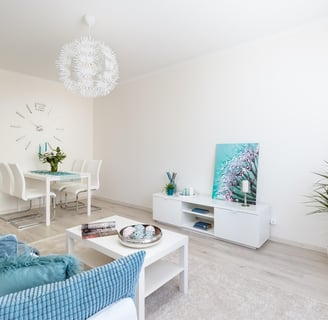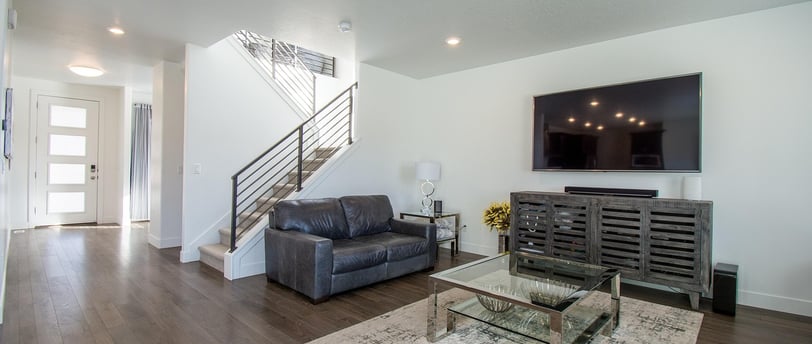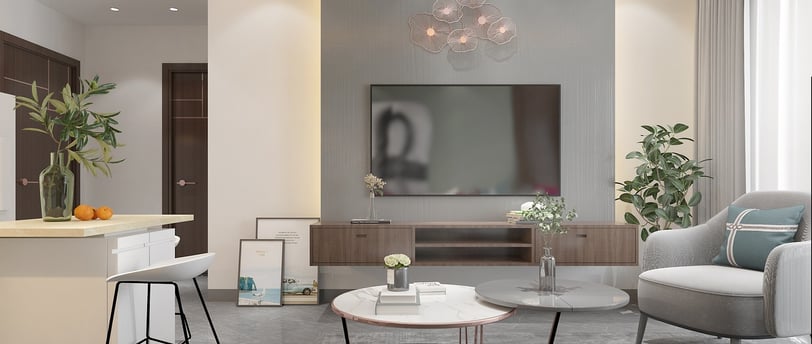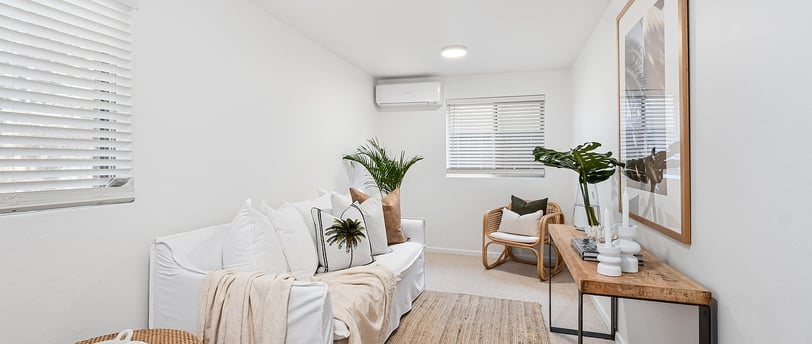What Furniture Should I Choose for a Minimalist Living Room?
What Furniture Should I Choose for a Minimalist Living Room? Minimalist living rooms prioritize furniture that serves a practical use. Pieces like storage ottomans or modular sofas combine utility with comfort. Function drives the choice of items rather
HOME COMFORT
Choosing furniture for a minimalist living room means focusing on pieces that prioritize function, clean lines, and simplicity. The best furniture is typically multi-purpose, with a sleek design that avoids unnecessary ornamentation and helps maintain an uncluttered space.
Neutral colors, natural materials, and minimalist shapes work well to create a calm, open atmosphere. It’s important to choose quality over quantity, selecting a few essential pieces like a streamlined sofa, a simple coffee table, and subtle storage solutions.
By carefully selecting these elements, the living room can remain both stylish and practical without feeling overcrowded. Minimalist furniture supports a balanced, airy environment where every item serves a clear purpose.




Key Principles of Minimalist Living Room Furniture
Minimalist furniture hinges on purposeful selection and restrained aesthetics. Every piece must have a clear role, with designs that avoid unnecessary adornment. Color and shape choices support a calm, unified space.
Emphasizing Function Over Form
Minimalist living rooms prioritize furniture that serves a practical use. Pieces like storage ottomans or modular sofas combine utility with comfort. Function drives the choice of items rather than their visual appeal alone.
Furniture should address specific needs: seating, storage, or surface area. This ensures the room stays uncluttered and purposeful. For example, a sofa with built-in storage reduces the need for additional cabinets.
Choosing multipurpose furniture maximizes efficiency. Items that can adapt, like extendable tables or fold-away chairs, suit smaller spaces and dynamic living. This focus prevents excess and retains the openness crucial for minimalism.
Prioritizing Clean Lines and Simple Silhouettes
Minimalist furniture is defined by sleek, straight lines and smooth curves. Ornate details, carvings, or excessive trims are avoided to maintain visual clarity. The shape should communicate simplicity and balance.


Geometric forms such as rectangles and circles appear frequently. Legs and edges are kept slim, contributing to an airy and spacious feel. This design approach prevents distraction and creates a sense of order.
Silhouettes tend to be low-profile to emphasize openness. Bulkier, heavy-looking pieces disrupt the minimalist aesthetic and may clutter the space. Visual lightness is key to the furniture's contribution.
Selecting a Neutral Color Palette
Colors in a minimalist living room generally consist of neutrals like white, gray, beige, and black. These tones blend seamlessly and do not compete with one another.
Neutral shades enhance natural light and support a sense of calm and space. They serve as a backdrop, allowing textures and materials to add subtle interest without overwhelming the eye.
Occasional accents in muted tones like soft blues or greens can be included to add warmth. However, the primary color scheme should remain restrained to preserve consistency and simplicity in the room’s design.
Essential Furniture Pieces for Minimalist Spaces
Minimalist living rooms require functional pieces that blend simplicity with utility. Key furniture selections focus on clean lines, neutral colors, and multipurpose designs that avoid clutter while maintaining comfort and style.
Choosing a Streamlined Sofa or Sectional
A minimalist sofa should have a simple silhouette without excessive cushions or ornamentation. Opt for a low-profile design with straight lines and muted fabric tones, such as gray, beige, or pastel shades.
Sectionals work well in larger spaces if chosen carefully. Look for modular designs that can be reconfigured and have slim arms and legs to keep the visual weight light.
Material choice matters; natural fabrics like linen or cotton offer texture without overwhelming the space. Avoid bulky upholstery or overly soft shapes that disrupt the minimal aesthetic.
Minimal Coffee and Side Tables
Coffee and side tables in minimalist rooms should emphasize function and form. Choose tables with thin metal or wooden legs and flat, unembellished surfaces.
Round or rectangular shapes work best to maintain flow and avoid visual clutter. Tables with integrated storage can reduce the need for additional furniture but must remain sleek.
Materials like glass or light wood help keep the room open and airy. Avoid oversized tables that dominate the floor space or have intricate details that draw unnecessary attention.
Incorporating Subtle Storage Solutions
Storage must be practical yet unobtrusive. Built-in shelves or wall-mounted cabinets in neutral colors minimize disruption to the minimalist design.
Choose pieces with flat fronts or push-to-open doors to eliminate the need for handles. Under-sofa storage or simple baskets can hold essentials without cluttering the room.
Hidden storage options, such as ottomans or benches, increase functionality while maintaining clean lines. The goal is to keep surfaces clear and maintain an uncluttered atmosphere.




Maximizing Space and Versatility
In a minimalist living room, every piece of furniture should contribute to both efficient use of space and functional flexibility. Prioritizing adaptable designs and smart layouts helps maintain a clean, open environment without sacrificing comfort or utility.
Opting for Multi-Functional Furniture
Multi-functional furniture maximizes room utility by combining several uses in one piece. Examples include sofas with built-in storage, coffee tables that convert into desks, or ottomans doubling as extra seating and storage.
This type of furniture reduces clutter by limiting the number of items needed. It also supports a minimalist aesthetic by maintaining sleek lines and avoiding unnecessary bulk.
Materials and finishes should be cohesive with the overall design theme. Choosing neutral colors and simple shapes enhances the seamless integration of multi-functional pieces into the space.
Arranging Furniture for an Open Layout
An open layout is essential for a minimalist living room to feel spacious and airy. Furniture placement should allow for clear pathways and avoid overcrowding.
Arranging larger pieces against walls creates a central flow and maximizes open floor area. Smaller items can be clustered strategically to define zones without barriers.
Using modular furniture supports rearrangement when needed. It offers versatility to adapt the room for different activities while preserving openness.
Key arrangement tips include:
Keep walkways at least 30 inches wide
Position seating to encourage natural conversation
Avoid excessive grouping of furniture in one corner
This thoughtful approach to layout fosters a sense of balance and simplicity.
Finishing Touches to Elevate Minimalism
A minimalist living room benefits from subtle details that enhance its simplicity without clutter. Combining varied textures and carefully chosen statement pieces creates depth while maintaining clean lines and clear space.


Integrating Textural Contrast
Textural contrast adds visual interest without overwhelming a minimalist design. Incorporating materials like a soft wool rug, a linen throw, or a leather sofa introduces tactile variety.
Wood elements, especially those with natural grains, complement smooth metals or glass surfaces. These differences engage the senses and break the monotony of flat, uniform surfaces.
Fabrics with subtle patterns or uneven weaves can also enrich the space. Choosing neutral colors maintains harmony but varies textures so the room feels warm and inviting instead of stark.
Adding One or Two Statement Pieces
A statement piece in a minimalist living room should be bold but not busy. This could be a mid-century modern chair, an oversized abstract art piece, or a uniquely designed coffee table.
The key is restraint—limit to one or two pieces that catch the eye without dominating the room. They provide a focal point but still respect the principle of minimal clutter.
Colors on these pieces often contrast gently with the rest of the space. For example, a matte black chair against white walls or a wooden sculpture on a neutral shelf can serve as effective accent points.
